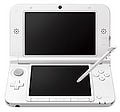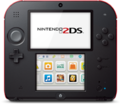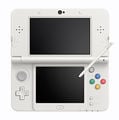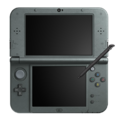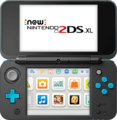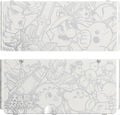Nintendo 3DS
| Nintendo 3DS | |
|---|---|
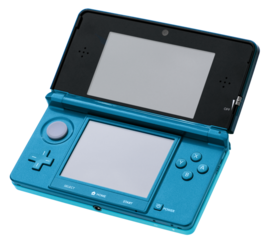 | |
| Manufacturer | Nintendo |
| Type | Handheld video game console |
| Generation | Eighth generation era |
| First available | |
| GPU | Digital Media Professionals PICA200 GPU |
| Media | Nintendo 3DS cartridge, Nintendo DS cartridge, Nintendo DSi cartridge, SD card (3DS, 3DS XL, 2DS), microSD (New 3DS, New 3DS XL, New 2DS XL) |
| System storage | Included 2 GB SD card (3DS) Included 4 GB SD card (3DS XL, 2DS) Included 4 GB microSD card (New 3DS, New 3DS XL, New 2DS XL) 256 MB internal flash memory Cartridge save |
| Controller input | Nintendo 3DS, Circle Pad Pro |
| Connectivity | Wi-Fi |
| Online service | Nintendo Network, Nintendo eShop, Nintendo Zone |
| Backward compatibility | Nintendo DS, Nintendo DSi, Virtual Console |
| Predecessor | Nintendo DS |
| Article on Nintendo Wiki | Nintendo 3DS |
The Nintendo 3DS is a handheld video game console released by Nintendo. The console is the direct successor to the Nintendo DS. It competed in the eighth generation of video game consoles with Sony's PlayStation Vita handheld.
The console is slightly less powerful than the Wii, and has an autostereoscopic 3D screen which allows a player to see an alterable level of 3D without the need to wear glasses. It also features a gyroscope, an accelerometer, and a touchscreen. The 3DS also features a wireless mode, active even in sleep mode, that renders it able to passively share information with other nearby 3DS systems, known as StreetPass. A mode similar to StreetPass, SpotPass also allows the 3DS to download data from the internet when the 3DS comes in range with a Wi-Fi hotspot. While moving, the built-in pedometer also allows the user to earn Play Coins. One Play Coin is earned for every 100 steps walked. The 3DS is fully backwards-compatible with the majority of DS and DSi games, though, like the DSi and DSi XL, it lacks a Game Boy Advance port that some DS games use such as Guitar Hero: On Tour. The built-in online shopping software Nintendo eShop, however, allows for the download of NES, SNES (New 3DS models only), Game Boy, Game Boy Color, and other third party handheld console games. Game Boy Advance games were also offered on the eShop via promotion once.
Nintendo first spoke of the console prior to the 2010 E3 press conference, and Nintendo released the system in Japan on February 26, 2011 and to North America in March 27, 2011.
A second model of Nintendo 3DS, the Nintendo 3DS XL, was released on July 28th in Japan and Europe, in North America on August 19th, and in Australia on August 23, boasting larger screens than the original Nintendo 3DS. A third variation of the 3DS, called the Nintendo 2DS, was released on October 12, 2013 in all regions except in South Korea and Japan where it was released on December 7, 2013 and February 27, 2016, respectively. It is considered a reduced-cost Nintendo 3DS, with a flat design rather than a clamshell design; requiring sleep mode to be accessed through a switch. It also lacks the option for 3D visuals.
In the Japan-exclusive Nintendo 3DS Direct on August 29, 2014, the fourth and fifth models (the New Nintendo 3DS and New Nintendo 3DS XL) were announced, released in Japan on October 11, 2014 and in Australia on November 21, 2014, with Europe and North America getting the handhelds on February 13, 2015. However, in North America, only the New Nintendo 3DS XL has been released at launch. The standard-sized model was released on September 25, 2015 in special bundles such as Animal Crossing: Happy Home Designer. Both models have ZL and ZR buttons, a C-Stick, more powerful hardware, different positioning of some buttons, automatic brightness depending on surrounding light levels, and 3D visuals that can be seen from a wider range of angles. Custom faceplates are available for the regular New Nintendo 3DS, but not the XL version due to size difference. The New 3DS also has built-in amiibo compatibility, whereas the original 3DS models require an adapter to interact with the figurines. A subsequent revision, the New Nintendo 2DS XL, would be released in mid-2017 worldwide, featuring a slimmer, streamlined design without the 3D visuals of previous variants.
The Nintendo 3DS line was discontinued worldwide on September 17, 2020.[1] The 3DS sold 75.94 million units worldwide, and stands as Nintendo's least-selling handheld platform, in large part due to the adoption of smartphones and tablets; however, it is still considered a success.
In the Super Smash Bros. series
Super Smash Bros. for Nintendo 3DS was released for the 3DS, marking the first time in the series that a Super Smash Bros. game has been playable on a handheld system. The Nintendo 3DS can also be used as a controller in Super Smash Bros. for Wii U by linking the two games; this is also possible without a copy of Super Smash Bros. for Nintendo 3DS by purchasing the Smash Controller application. A demo for the game was also released in Japan on September 9th, 2014, and special codes for an unlimited demo were sent out on September 12th, 2014. Full access to the demo outside of Japan was granted on September 19th, 2014.
A special version of the Nintendo 3DS XL was also released that featured characters from Super Smash Bros. in poses similar to those of the Super Smash Bros. for Nintendo 3DS boxart. A similarly designed faceplate was also released for the standard size New Nintendo 3DS.
Ever since Super Smash Bros. 4, many characters originating from Nintendo 3DS games were included as playable characters in the Super Smash Bros. series:
- Dark Pit, Robin, Lucina, Greninja and Corrin in SSB4.
- Chrom, Isabelle, Incineroar and Hero's Luminary costume in Ultimate.
Standard controls (Super Smash Bros. for Nintendo 3DS & Super Smash Bros. for Wii U)
- The controls are customizable. These are the default controls. Note that the D-Pad cannot be customized, and can only be used to perform taunts. The New 3DS's C-Stick cannot be customized either and is used for Smash attacks. ZL and ZR have the reversed function as L and R.
| Move | |
| Standard attacks | |
| Special moves | |
| Jump | |
| Shield | |
| Grab | |
| Taunt | |
| Pause | |
| Home Menu |
Super Smash Bros. themes
The Theme Shop on Nintendo 3DS systems allows for purchase of various home menu themes. Four themes related to Super Smash Bros. 4 are available, each coming with appropriate music.
| Title | Image | Music |
|---|---|---|
| Super Smash Bros.: Theme 1 | 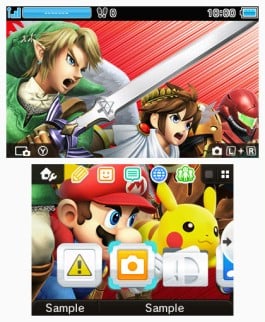 |
Menu (Wii U) |
| Super Smash Bros.: Theme 2 | 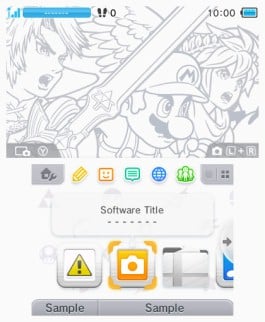 |
Online Practice Stage |
| Super Smash Bros.: Theme 3 | 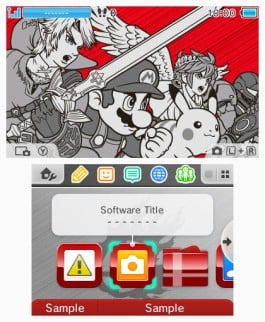 |
Menu (3DS) |
| Super Smash Bros.: Theme 4 | 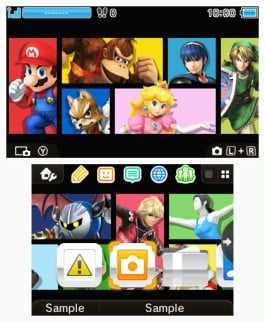 |
Results Display Screen |
In competitive play
Due to being the original hardware the game was designed for, the 3DS is the prefered system to play Super Smash Bros. for Nintendo 3DS, especially in tournaments. The game has never been re-released on another system, so players with physical copies can only use the 3DS. While emulators exist, they are merely recreating original hardware and possess bugs and performance issues not present on 3DS. However, the isolated nature of the game and the aging hardware that is becoming progressively less reliable have forced the competitive scene to consider and experiment with these alternatives before the game the love becomes unplayable, and emulation developers have made great strides in making a nearly identical experience.
The competitive scene for Super Smash Bros. for Nintendo 3DS, despite essentially being the same as its Wii U counterpart in a competitive sense, always had a significantly smaller scene. This was due to players generally prefering to play Smash in a high resolution on a big screen, which the 3DS explicitly did not do but the Wii U did. The 3DS version did have slightly over two months all to itself, but that was not enough to grow a scene and very few major tournaments specific to this version have occured.
There are a few noteworthy aspects specific to the 3DS scene. First off, it has a completely different stage list, leading to a completely different competitively legal stage list. The console exclusive Smash Run has also developed a niche speedruning community, with players attempting to complete the mode in the fastest time and/or the highest score. StreetSmash has also developed a niche competitive scene, sometimes seen as side events in major tournaments.
As a controller
Due to the 3DS essentially being the only official control scheme for Super Smash Bros. for Nintendo 3DS and being required to play the game, it was essentially the only controls used for the relatively few major tournaments for that game.
Despite being an official control scheme for Super Smash Bros. for Wii U, the 3DS was rarely used in tournaments. This was due to the logistical hurdles of either owning a copy of both games or paying extra to use the controller functionality, and the controls itself being considered worse than most other options due to its restricted functionality without addons like the Circle Pad Pro. However, the New 3DS and its built-in C-stick improved its viability as a controller and retroactively improved the 3DS entry by making it control more like other games in the series.
Gallery
References
| Nintendo consoles | |
|---|---|
| Home consoles | Color TV-Game 15 · Nintendo Entertainment System · Super Nintendo Entertainment System · Virtual Boy · Nintendo 64 · Nintendo GameCube · Wii · Wii U |
| Handheld consoles | Game & Watch · Game Boy · Game Boy Color · Game Boy Advance · Nintendo DS · Nintendo 3DS |
| Hybrid consoles | Nintendo Switch |
| Controllers and buttons | |
|---|---|
| Nintendo 64 controller | |
| GameCube controller | |
| Wii Remote (and Nunchuk) | |
| Classic Controller | L |
| Nintendo 3DS | |
| Wii U GamePad / Pro Controller | L |
| Joy-Con | |
| Switch Pro Controller | L |
| Third-party controllers | Hori Mini Pad · Arcade controller · Keyboard |
| Other | Smash Controller · Controller modification |













